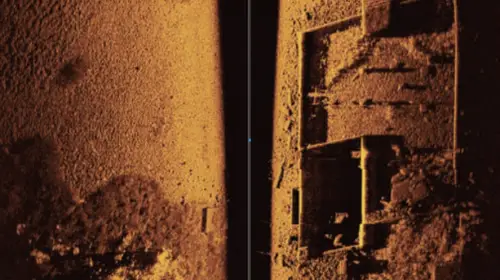Is Humminbird Mega Imaging Worth The Money? (Here’s What You Need To know)
UPDATED 17 MAY 2023
by Robert Ceran
Are you thinking about getting a Humminbird fish finder with Mega imaging?
Since its release in 2016, Humminbird Mega imaging has revolutionized the fish finder market with unprecedented levels of resolution, clarity and detail.
But you’re probably wondering exactly what Mega imaging is capable of, and whether it’s really worth the extra money.

In this article we’ll discuss what you can expect from Humminbird Mega imaging, so you can make an informed decision whether Mega imaging is worth it for you or not.
Is Mega imaging worth the extra money?
Yes, Mega imaging is definitely worth the extra money, as it provides some of the most detailed and accurate sonar imaging currently available on the market.
The additional level of resolution provided by Mega imaging allows you to identify fish relating to structure, which are usually difficult (and sometimes impossible) to see with regular imaging.
Most anglers who try Mega imaging for the first time describe the difference as ‘night and day,’ and usually don’t want to go back to regular imaging afterwards.
However, with that being said, while Mega imaging does provide the greatest target separation, it also has a shorter effective range than regular sonar, so ideally it’s best to have both Mega imaging and regular imaging at your disposal, so you can use each of them in situations where they work best.
What is Humminbird Mega imaging, and how does it work?
Humminbird Mega imaging is a high frequency sonar technology that uses CHIRP sonar in the 1.2 megahertz range, and provides images with much higher target resolution than lower frequency sonar.
Traditional sonar uses lower frequencies around 455 kHz or 800 kHz, which generate lower target resolution (though they come with the advantage of great depth range).
In 2016, Humminbird released their first Mega transducer able to transmit in the megahertz range, and this marked the start of their Mega imaging.
In my experience, Humminbird Mega side imaging and Mega down imaging generate some of the sharpest and clearest images you can get on a fish finder, especially when it comes to shallow water fishing.
Mega imaging vs regular compared
The main difference between Humminbird Mega imaging and regular imaging is that Mega imaging generates much higher resolution images, but is only effective at short ranges under 100 feet, while regular sonar provides lower resolution, but works better at longer ranges over 100 feet.
This difference is due to Physics: the high frequency 1.2 MHz wavelength of a Mega imaging sonar beam can achieve greater object resolution, but has a shorter effective range than lower frequency sonars.
Traditional sonars that transmit at 455 or 800 kHz, on the other hand, have a longer effective range in the water, but due to their longer wavelength are unable to achieve the same high object resolution as Mega imaging.
How much better is Mega imaging?
The additional level of clarity, detail and sharpness provided by Mega imaging is much better than that of regular sonar.
For example, if you can see a laydown on your regular sonar, Mega imaging can reveal a lot of additional details, including individual fish tucked in between the branches of the laydown.
Needless to say, this can help to put a lot more fish in the boat.
The high resolution clarity of Mega imaging is a game changer for most anglers, as it not only helps you to identify potential fish-holding structures, but also allows you to see the fish that are close to those structures.
It even helps you to get a good sense of what species and size range you’re dealing with.
With that being said, lower frequency imaging is also very useful, as it has a longer range, and allows you to scan larger areas at a time.
So the best option would be to have all the main sonar wavelengths (455 kHz, 800 kHz, and 1200 kHz) available to you, so you can harness the advantages of each.
What is Mega side imaging?
Mega side imaging is a sonar technology that shoots two sonar beams out on both sides of the transducer, and thereby covers a broad area of lake bottom to both sides of your boat (for an example, check out the photo below) .

The beamwidth of a Mega side imaging transducer is relatively wide, which is ideal for scanning a large area of lake bottom at once. This is different from Mega down imaging, which uses a very narrow beamwidth to focus on a small area of lake bottom.
Is Mega side imaging worth the money?
Yes, Mega side imaging is definitely worth the money, as it allows you to get incredibly detailed structure scans to either side of your boat as you drive around.
Since the target resolution of Mega side imaging is much higher than regular side imaging, you’ll be able to spot important details that you would miss otherwise, including bluegill beds, weed beds, and even fish.
What is Mega down imaging?
Mega down imaging is a sonar technology that shoots a narrow sonar beam straight down in the water, and enables you to get a very detailed view of structure and fish right under your boat.

Since the beamwidth of Mega down imaging is relatively narrow, it scans a cross section of the water straight underneath the transducer, while ignoring anything else.
The high resolution provided by Mega imaging combined with down imaging results in sonar images with unprecedented clarity and detail (for an example of this, check out the photo above).
Is Mega down imaging worth the money?
Yes, Mega down imaging is absolutely worth the money, as it helps you to get very high resolution sonar image of what’s going on right underneath your boat.
With that being said, if you’re mostly fishing in shallow water under 20 feet, you probably won’t be focused on fishing right underneath your boat, in which case Mega side imaging would be a better option for you.
Also, if you fish mostly in deep water over 100 feet, Mega down imaging isn’t effective at these longer ranges. In that case you’re better off with a regular 455 or 800 kHz transducer, which can penetrate deeper into the water column.
What’s the difference between Mega imaging and Mega imaging plus?
The main difference between Mega imaging and Mega imaging plus is that the latter is an improved version that comes with a longer range of up to 200 feet according to Humminbird, though the effective range is closer to 150 feet in my experience.
In addition to the extended range, Mega imaging plus also comes with dual spectrum CHIRP, which provides even better target separation and hence more detailed images.
In short, Mega imaging plus is currently the highest quality Mega imaging built by Humminbird.
If you’re currently thinking about getting Humminbird’s MEGA Live for your boat, check out our article on what the Humminbird MEGA Live compatible units?
Which Humminbird models have Mega imaging?
The Apex and Solix lineups, as well as more high end Helix units (starting with the Helix 7) are available with Mega imaging functionality.
Units with Mega imaging have either Mega SI, DI, SI+, or DI+ included in their name, which makes it easy to find them.
